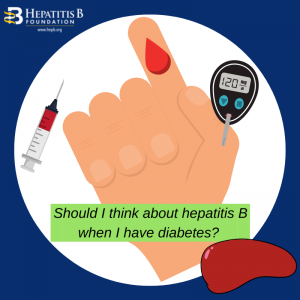
Happy Diabetes Awareness Month
November is American Diabetes Awareness Month! The Hepatitis B Foundation invited Dr. Tatyana Kushner, Theresa Worthington, and Marcia Mukanga Lange from Icahn School of Medicine at Mount Sinai to explain more about the relationship between hepatitis B and Diabetes.
Diabetes and hepatitis B are linked in ways that are important for patients and healthcare professionals to be aware of in order to improve outcomes in patients with chronic hepatitis B. The great news is that through healthy lifestyle changes, patients with chronic hepatitis B and diabetes can take ownership of their health and manage their diabetes.
Hepatitis B May Increase One’s Risk for Diabetes
While still controversial, some studies indicate that patients with chronic hepatitis B, and particularly cirrhotic (liver scarring) hepatitis B, are at a greater risk for developing type II diabetes. Type II diabetes is a medical condition in which the body is unable to use glucose (blood sugar) for energy. The liver is a key metabolic organ with a host of necessary functions, one of which is blood sugar regulation. The liver helps keep glucose levels normal in the bloodstream to prevent serious health issues. It is not clearly understood how hepatitis B increases one’s risk for diabetes, but research has shown that damaged liver cells could lead to abnormalities in blood sugar regulation. Liver damage as a result of hepatitis B can promote the development of diabetes without effective management to prevent further complications.
It is also important to know that having diabetes can put a person at risk for hepatitis B due to frequent use of glucose monitoring devices. People with diabetes must regularly monitor and track their blood sugar or glucose levels by pricking their finger using a glucose meter/monitoring machine. Failure to clean the equipment properly or sharing the glucose monitor with others can result in the spread of hepatitis B. Therefore, people with diabetes should make sure they are vaccinated against hepatitis B to reduce the risk of transmission.
Hepatitis B Increases Risk of Gestational Diabetes (being diagnosed with diabetes for the duration of the pregnancy)
Research has also pointed to an increased risk of developing gestational diabetes in pregnant patients with chronic hepatitis B, likely also due to damaged liver cells. Gestational diabetes is distinct from type I or type II diabetes in that it is diagnosed specifically during pregnancy. The cause of gestational diabetes is unknown but likely related to the hormonal changes that occur during pregnancy. Being overweight or having pre-diabetes are two well known risk factors, aside from chronic hepatitis B, that increase a patient’s risk for developing gestational diabetes. Gestational diabetes is associated with harmful outcomes for the mother and baby, especially if not well controlled during pregnancy. These may include:
- High blood pressure during pregnancy
- Premature birth associated with breathing problems
- Complications during delivery (giving birth to a child weighing nine pounds or more)
- Developing type II diabetes later in life
Hepatitis B and Diabetes Comorbidity (being diagnosed with multiple conditions at the same time) Increases Risk for Cirrhosis and Liver Cancer
Chronic hepatitis B patients with diabetes are also at a greater risk for a more rapid progression of liver disease, including progression to cirrhosis, a condition where the liver is scarred and becomes permanently damaged.
Moreover, chronic hepatitis B and diabetes are known risk factors for hepatocellular carcinoma, a type of liver cancer. When a patient has both hepatitis B and diabetes, the risk of hepatocellular carcinoma is even greater, likely due to liver inflammation as a result of insulin resistance (a condition in which the body cannot break down sugar for energy). However, this risk can be reduced with proper blood sugar control. Interestingly, treating patients who have both diabetes and chronic hepatitis B with metformin, a diabetes medication that improves blood sugar levels, decreased the incidence of liver cancer to a greater degree than treating patients with insulin directly. Thus, both cautious and appropriate management of diabetes in HBV patients is critical.
Other Metabolic Risk Factors
Other metabolic-related risk factors for liver disease and liver cancer exist including nonalcoholic fatty liver disease (NAFLD). NAFLD is a liver condition associated with an accumulation of excess fat on the liver that is not caused by alcohol consumption. Common risk factors for NAFLD include type II diabetes and obesity. As vaccination rates and treatments for hepatitis B continue to improve, NAFLD is quickly becoming the leading cause of liver disease, liver cancer, and liver transplantation in the United States. Patients living with both NAFLD and HBV are more likely to have their liver disease rapidly progress. Thus, providers should counsel patients with chronic hepatitis B, with or without diabetes, to manage their weight through healthy eating and physical activity. For those with diabetes, optimizing control of blood sugar levels in order to improve both overall and liver-specific health is also key.
References
Cheuk-Fung Yip T, Wai-Sun Wong V, Lik-Yuen Chan H, Tse YK, Pik-Shan Kong A, Long-Yan Lam K, Chung-Yan Lui G, Lai-Hung Wong G. Effects of Diabetes and Glycemic Control on Risk of Hepatocellular Carcinoma After Seroclearance of Hepatitis B Surface Antigen. Clin Gastroenterol Hepatol. 2018 May;16(5):765-773.e2. doi: 10.1016/j.cgh.2017.12.009. Epub 2017 Dec 12. PMID: 29246694.
Lei S, Chen S, Zhao X, Zhang Y, Cheng K, Zhang X, Wang Z, Sun Y, Wu S, Wang L. Hepatitis B virus infection and diabetes mellitus: the Kailuan prospective cohort study in China. Hepatol Int. 2020 Sep;14(5):743-753. doi: 10.1007/s12072-020-10086-2. Epub 2020 Sep 3. PMID: 32885367.
Liu Y, Ye S, Xiao X, Zhou T, Yang S, Wang G, Sun C, Zhang B, Wang G. Association of diabetes mellitus with hepatitis B and hepatitis C virus infection: evidence from an epidemiological study. Infect Drug Resist. 2019 Sep 12;12:2875-2883. doi: 10.2147/IDR.S218536. PMID: 31686868; PMCID: PMC6751765.
Tacke F, Weiskirchen R. Non-alcoholic fatty liver disease (NAFLD)/non-alcoholic steatohepatitis (NASH)-related liver fibrosis: mechanisms, treatment and prevention. Ann Transl Med. 2021 Apr;9(8):729. doi: 10.21037/atm-20-4354. PMID: 33987427; PMCID: PMC8106094.
Tan Y, Wei S, Zhang W, Yang J, Yang J, Yan L. Type 2 diabetes mellitus increases the risk of hepatocellular carcinoma in subjects with chronic hepatitis B virus infection: a meta-analysis and systematic review. Cancer Manag Res. 2019 Jan 14;11:705-713. doi: 10.2147/CMAR.S188238. PMID: 30679924; PMCID: PMC6338123.
Xu C, Chen J, Zhang PA. Relationship Between Diabetes Mellitus and Cirrhosis Risk in Chronic Hepatitis B Patients in Wuhan, China. Med Sci Monit. 2019 Oct 29;25:8112-8119. doi: 10.12659/MSM.917000. PMID: 31661471; PMCID: PMC6839395.
Zhang, J., Shen, Y., Cai, H., Liu, Y.-M., and Qin, G. (2015) Hepatitis B virus infection status and risk of type 2 diabetes mellitus: A meta-analysis. Hepatol Res, 45: 1100– 1109. doi: 10.1111/hepr.12481.
https://www.cdc.gov/diabetes/basics/gestational.html
https://www.cdc.gov/hepatitis/populations/diabetes.htm


